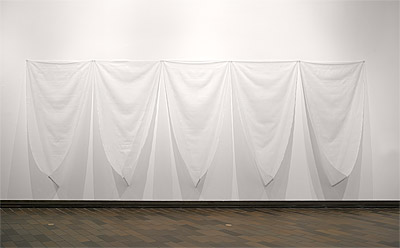Robert
RAUSCHENBERG
United States of America
1925
–
2008
Reef (Jammer)
1976
silk
not signed, not dated
overall
233.0 (h)
x 632.0 (w)
x 60.0 (d)
cm
Purchased 1979
National Gallery of Australia, Canberra
NGA 1980.224.A-E
© Robert Rauschenberg. Licensed by VAGA & VISCOPY, Australia
Throughout his long and celebrated career, Robert Rauschenberg was fascinated by the sculptural possibilities of fabric. The artist skilfully manipulated all kinds of material in his radical theatre costumes, stage sets, and print projects. Fabric was also an integral component within many of his most famous ‘Combines’—a fusion of the two-dimensional painterly surface with three-dimensional sculptural form.
In 1974 Rauschenberg’s interest in fabric peaked when he observed a team of printmakers using large sheets of gauze to wipe down lithographic stones. These strips of fabric were subsequently hung up to dry, their translucent shapes shifting and floating on the breeze, fixating the artist. Rauschenberg’s striking Hoarfrost editions series of printed layers of silk, muslin and cheesecloth was the direct result of this renewed enthusiasm for fabric as a medium.
A year later, following a trip to the rich textile area of Ahmadabad in India, Rauschenberg further exploited the unique qualities of fabric in a series of large, bold silk works titled Jammers. One of the most magnificent of these works is the soft sculptural piece Reef (Jammer)—a minimal installation of five white sheets of silk, suspended by pins and elegantly draped to flutter in the breeze. Whilst the titles of the works in the series are nautical in reference, Reef (Jammer) itself functions as a Zen meditation piece, recalling the ‘hyper-sensitive’ receptor surface of Rauschenberg’s series of white paintings from 1951.[1]
This alternative reading of Reef (Jammer) is supported by a close analysis of the relationship of reciprocal exchange between Rauschenberg and John Cage. The avant-garde composer credited Rauschenberg as the source of inspiration for his famous musical score 4” 33’—a piano piece in which the pianist–performer opens the lid of the piano and sits in silence for exactly four minutes and thirty-three seconds, at which point the performance ends with the protagonist closing the lid of the piano. Instead of music, the audience is forced to listen to the random noises of the surrounding space—the stirrings of the people next to them, the creaks of the floorboards, the wind on the roof—and all become components of the ‘empty score’. The piece is a contemplation of the softest and slightest sounds of the chance events taking place when one stops to listen and focus on the sounds of a unique moment in time.
In exactly the same way, Rauschenberg’s Reef (Jammer) can be viewed as a conduit for what is happening in the surrounding environment: the fabric hangs delicately, softly moving in the wake of passers-by or a sudden draught of air. It projects a quiet ‘emptiness’, but is far from passive. The viewer who takes time to meditate upon its surface and form will notice the casting of chance shadows and irregular accidental movements. Suddenly, the expansive white ‘emptiness’ of Reef (Jammer) appears not so empty after all.
Jaklyn Babington
Assistant Curator
International Prints, Drawings and Illustrated Books
National Gallery of Australia, Canberra
[1] John Cage, ‘On Robert Rauschenberg, artist, and his work’ (first published in Metro, Milan, 1961); republished in Silence, 4th edn, The MIT Press, Cambridge, Massachusetts and London, England, 1970, p 105

